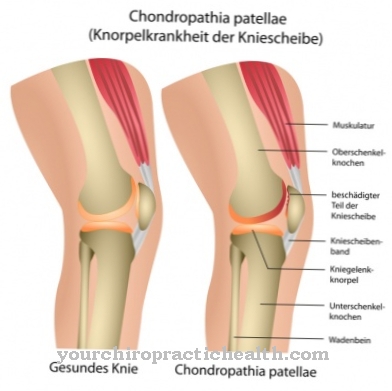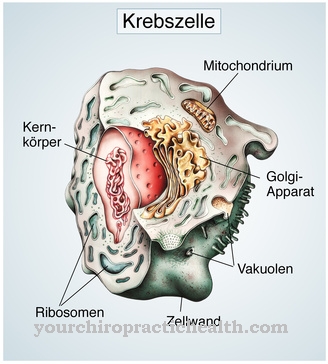What is Paratyphoid?

© Henrie - stock.adobe.com Of the Paratyphoid is a weakened form of the infectious disease typhoid. Pathogen is here Salmonella paratyphi.
The pathogens are distributed worldwide, but infections are more likely to be found in countries with poor hygiene conditions. The disease manifests itself through symptoms such as headache, rash, diarrhea, constipation, and hair loss.
There is a high fever. Some patients become permanent excretors after being infected with paratyphoid fever.
causes
The disease is caused by the pathogen Salmonella paratyphi. This belongs to the Salmonella enterica family and can have serotypes A, B and C. The pathogen is gram-negative bacteria. They are agile and facultatively anaerobic. Salmonella paratyphi is distributed worldwide. Every year around 5.5 million people in the world develop paratyphoid fever.
The highest incidence rates are recorded in Africa, South America and southern Asia. In 2006, 75 cases of paratyphoid were reported to the Robert Koch Institute in Germany. Around 75 percent of the diseases were imported from India, Turkey or Serbia. The pathogen reservoir for Salmonella of the Paratyphi type is exclusively humans. In particular, permanent eliminators and asymptomatic patients play an important role in the spread.
Permanent eliminators are people who permanently excrete the pathogen with their stool. In order to obtain permanent excretion status, salmonella must be detectable in the stool ten weeks after the onset of the disease. Infection with Salmonella paratyphi occurs mainly through ingestion of contaminated water or contaminated food. Direct transmission from one infected person to another is also conceivable. However, since this has to take place faecal-orally, this transmission route is of minor importance. The incubation period is one to ten days. The risk of infection begins about seven days after the onset of the disease and can persist for several weeks beyond the symptoms. Two to five percent of all sick people remain asymptomatic long-term excretors.
Symptoms, ailments & signs
The disease begins with general symptoms such as aching limbs, a slight increase in temperature or headache. The fever rises to 39 degrees Celsius within two to three days. Those affected feel very sick. Constipation, diarrhea, vomiting, nausea and abdominal pain develop. Typical for typhoid and paratyphoid are bright red skin symptoms on the abdomen.
These are also known as roseoles. However, they rarely occur. Relative bradycardia also occurs in some cases. Normally, if you have a fever, the pulse rises ten beats per minute for every degree of temperature increase. In the case of relative bradycardia, this pulse adjustment remains on. The temperature is high, but the pulse is normal. Complications such as peritonitis, inflammation of the bile ducts, heart inflammation or intestinal bleeding can occur.
Intestinal perforations or meningitis are also possible complications. In the case of untreated paratyphoid, the convalescence time is very long. If subefebrile temperatures persist even after the symptoms have subsided, this can be an indication of a relapse. Multiple recurrences are also possible. As a rule, however, the disease ends after four to ten days. A survived infection leaves immunity for about a year.
Diagnosis & course of disease
Paratyphoid infections should be included in the differential diagnosis, especially after trips or stays abroad. In the laboratory, shifts to the left in the blood count and leukopenia provide indications of an infection with Salmonella paratyphi.
However, only the pathogen detection is proof. Evidence is provided by culture from the blood. Antibodies against the pathogen can also be detected with the help of the Widal test. This procedure is very simple and quick, but not particularly specific and sensitive. Therefore it is only used in connection with a clinically proven infection.
Complications
As a result of paratyphoid fever, those affected suffer from the complaints and symptoms of gastrointestinal flu. These complaints have a very negative effect on the patient's quality of life and can make everyday life much more difficult. The primary cause of the disease is diarrhea and constipation. Nausea and vomiting can also occur, although in most cases those affected also suffer from relatively severe abdominal pain.
There is also a fever and severe pain in the extremities and head. If the disease is not treated, it can also lead to inflammation in the internal organs of the person concerned. Bleeding in the intestines is also not uncommon. Furthermore, inflammation of the meninges also occurs, which, in the worst case, can lead to death without treatment.
After successful treatment, the person affected is immune to the disease for a period of time. Treatment is carried out with the help of antibiotics, there are no particular complications. The life expectancy of the patient is also not affected by successful treatment. Other inflammations caused by paratyphoid fever may also need treatment.
When should you go to the doctor?
If you have a high fever, gastrointestinal discomfort or are very unwell, a doctor is recommended. Paratyphoid also manifests itself in headache and body aches as well as the characteristic reddish spots on the chest, stomach and back. A whitish coating on the tongue clearly indicates a paratyphoid and must be checked by a doctor immediately so that any complications can still be averted. Anyone who recently consumed eggs, ice cream and other foods with an increased salmonella risk should have the symptoms clarified by a doctor immediately.
Contact with stool, urine and other substances that may already be contaminated is a risk factor that indicates an infection with paratyphoid fever or another pathogen and must be clarified by a doctor.Paratyphoid fever is treated by your family doctor or a specialist in internal diseases. Children are first examined by the pediatrician in charge, who can then initiate measures directly or refer the parents to a suitable specialist. Close consultation with the healthcare professional should be maintained during treatment.
Therapy & Treatment
The therapy of paratyphoid always takes place with antibiotics. Broad-spectrum antibiotics are mostly used. But the gyrase inhibitor ciprofloxacin is also used. The duration of therapy is around two weeks. With antibiotic therapy, the lethality is less than one percent. Complications only rarely occur with this form of therapy. Permanent eliminators are also treated with antibiotics. It is recommended to give it over a period of at least one month. If the permanent eliminators also suffer from gallstones, removal of the gallbladder may be necessary.
Outlook & forecast
The typhoid-like paratype can have a mild as well as a severe course. The prognosis is correspondingly different. If the clinical picture is severe, the paratyphoid patient must be treated with antibiotics. That should be done in a clinic.
The affected person can only be treated on an outpatient basis if the course is mild. However, this requires perfectly hygienic care. Patients with paratyphoid need to be isolated from other people. The prognosis improves with the care with which carers treat the patient. However, the increasingly common antibiotic resistance is problematic. These make the successful treatment of paratyphoid more difficult. The risks of failed treatment are higher than before.
It can take days for treatment to work. To improve the chances of recovery from paratyphoid fever, antibiotic therapy should last long enough. Paratyphoid relapses must be ruled out. Often there are complications such as intestinal bleeding and intestinal perforations. Such difficulties occur in those affected who cannot be treated successfully or who are given antibiotic therapy late.
Paratyphoid complications have a high mortality rate. Emergency surgery can save the lives of some. However, postoperative complications are not uncommon. The prognosis is best if the paratyphoid is detected early and the therapy starts early. That reduces the mortality rate down to one percent.
prevention
Paratyphoid is mostly transmitted through drinking water. Tap water should therefore not be drunk in areas where the disease is widespread. Ice cubes should also be avoided in these countries, as these are often made from tap water. Raw or insufficiently heated food, such as salads or fruit, can also be contaminated with paratyphoid pathogens. The same goes for seafood.
A vaccine is also available for typhus. However, there is no vaccination against paratyphoid fever. To protect the environment, people suffering from paratyphoid fever are not allowed to work in food production. This also applies to permanent dropouts. They are prohibited from producing, treating and placing certain foods on the market.
These foods include sprouts, meat, meat products, milk, dairy products, egg products, baby food, ice cream, baked goods with insufficiently heated fillings, delicatessen salads, raw vegetable salads and mayonnaise. Likewise, sick people are not allowed to stay in community facilities such as schools or kindergartens.
Aftercare
Follow-up care for paratyphoid initially involves strengthening the immune system that has been weakened by the disease. The patients slowly get used to the daily stresses again, whereby intensive sport should be avoided at first. The doctor specifies when the affected person can return to physically demanding activities. A healthy diet supports the regeneration of the body after paratyphoid fever.
The restoration of the intestinal flora is also of particular importance. The stomach and intestines are sometimes severely impaired by paratyphoid fever and are more susceptible to digestive problems and pathogens for weeks to months after the actual illness. For example, the intake of lactic acid bacteria can help to rebuild the intestinal flora, although you should always consult your doctor.
The diet also plays an important role in aftercare. For a few weeks after paratyphoid fever, patients pay particular attention to the choice of their food and avoid irritating foods, such as spicy foods. Much importance is attached to the preparation of food so that existing germs are killed as far as possible.
Meals that are gentle on the stomach contain well-cooked foods that facilitate digestion and support the regeneration of the stomach and intestines. Suitable and individually tailored recipes are also available from the attending physician or a nutritionist.
You can do that yourself
If the diarrhea persists and vomiting occurs frequently, those affected must above all ensure adequate fluid intake. Still water and sugar-free teas are ideal. If necessary, a special glucose-electrolyte mixture from the pharmacy can also be used. Grated apples, bananas and the intake of intestinal sanitizing probiotics also provide relief.
To reduce nausea and vomiting, we recommend a particularly light diet with several small servings spread over the day. In addition, peppermint and ginger tea can be drunk against nausea and loss of appetite. At first, alcohol and nicotine should be avoided entirely. Sufficient rest must also be ensured.
For mild headaches, head massages, peppermint oil applied to the temples and fresh air help. If the pain is more severe, painkillers can also be taken after consulting the attending physician. They then also lead to a reduction in the fever, which usually also occurs. This can also be reduced with cold leg compresses, by wearing light clothing and with elderberry or linden blossom tea.
Infectious paratyphoid fever also requires sustainable hygiene in order to avoid infecting third parties. The most important measures include regular and thorough hand washing, especially after a bowel movement, careful cleaning of used sanitary items and washing clothes, towels and bed linen as hot as possible.

.jpg)

.jpg)


.jpg)


















.jpg)

.jpg)
